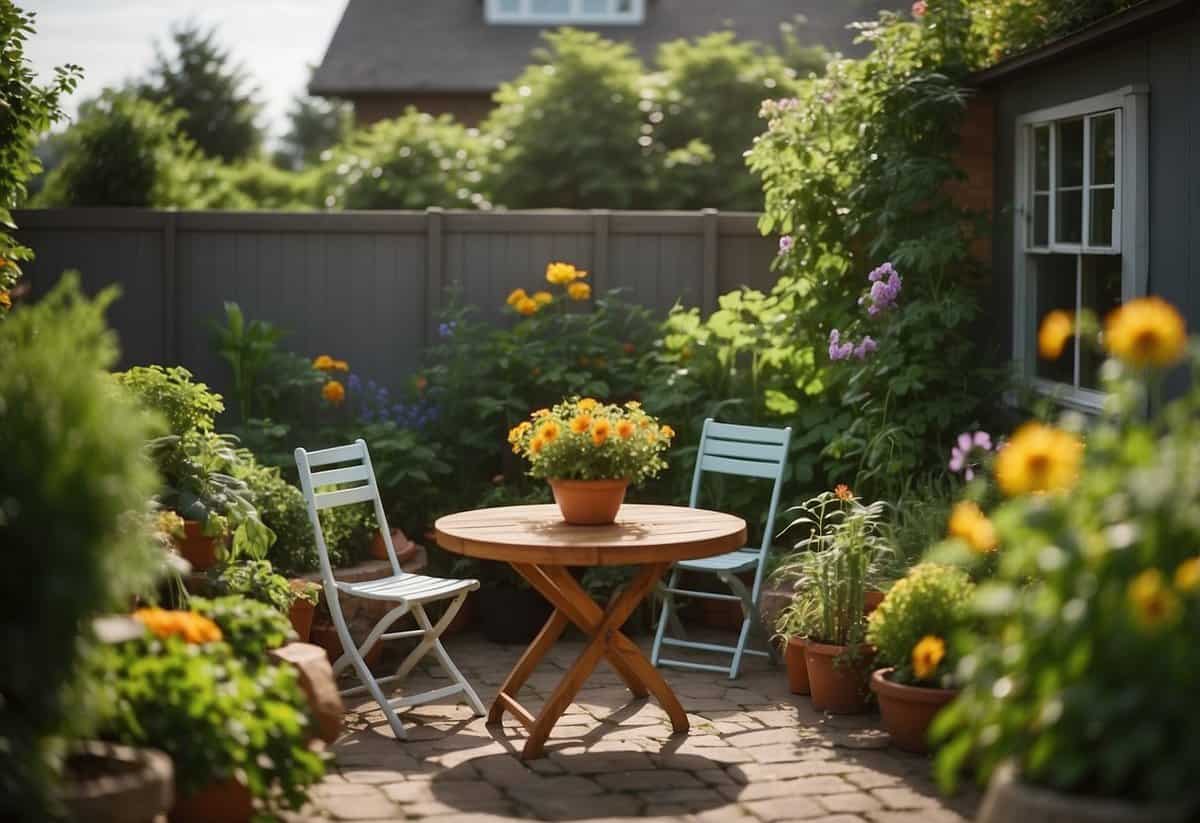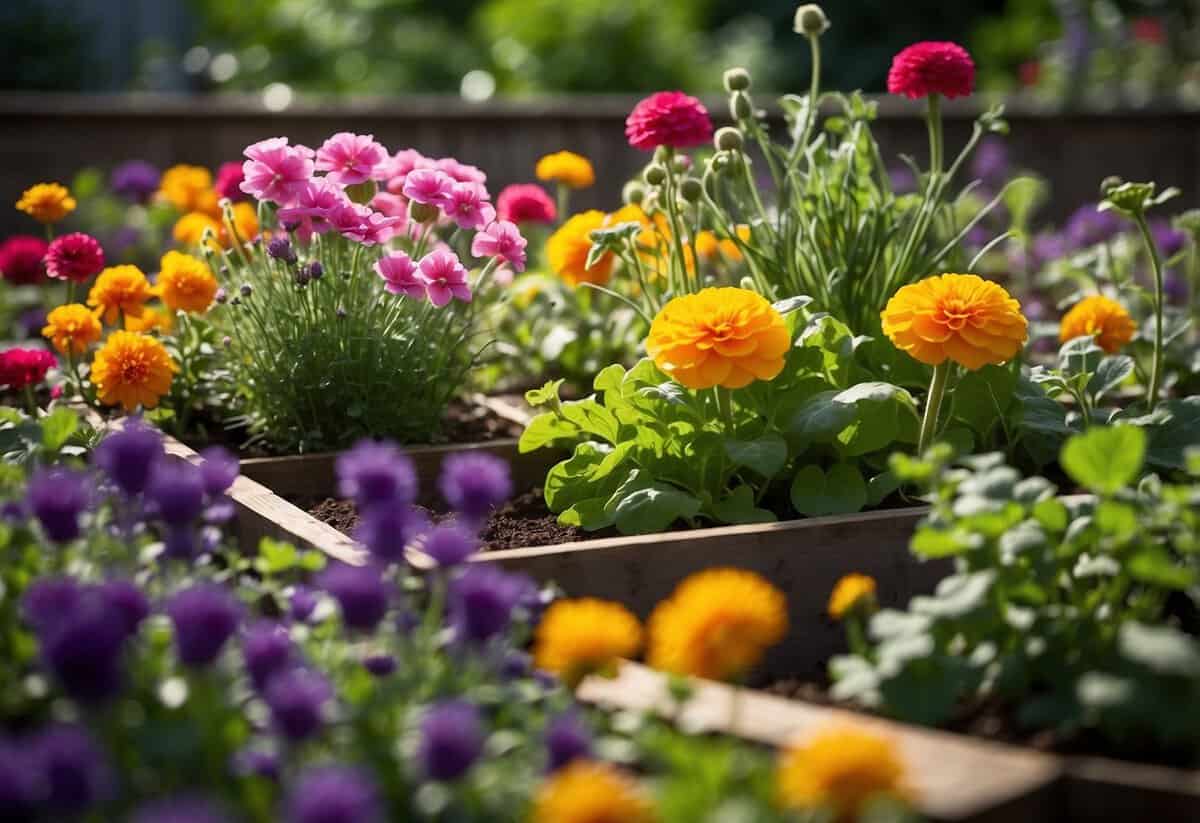Small Backyard Garden Tips: Easy Ideas for a Blooming Oasis
Creating a beautiful garden in a small backyard can seem challenging, but with the right tips, you can transform even the tiniest space into a green oasis. Whether you’re a beginner or an experienced gardener, you’ll find plenty of ways to make the most of your outdoor area.

You’ll discover how to use your space efficiently, making every square inch count. From smart planting ideas to clever design techniques, you can bring life and color to your backyard in no time. Get ready to enjoy your own little patch of paradise!
1) Use Raised Beds

Using raised beds in your small backyard garden can make a big difference. They help keep your plants organized and easier to manage.
Raised beds improve soil quality by allowing better drainage. This can help your plants grow stronger and healthier.
You can build raised beds from wood, stone, or even recycled materials. They also add a nice visual touch to your garden.
Try using a mix of vegetables and flowers in your raised beds for a colorful and productive space. For ideas, check out these raised garden bed designs.
2) Incorporate Vertical Gardening

Vertical gardening is a great way to add more plants to your small backyard. It uses walls, trellises, or fences to grow plants vertically, which saves space.
Hanging planters, shelves, and containers work well. Drip irrigation systems can keep your vertical garden well-watered, ensuring healthy plants. You can even use simple tools like a watering can or a hose with a gentle spray nozzle.
Try placing climbing plants like strawberries or grapes on a trellis. For more ideas, check out this guide on building a vertical garden in a small space.
3) Focus on Container Gardening

Container gardening is perfect if you have limited space in your backyard. Using pots or containers allows you to grow a variety of plants without needing a traditional garden plot.
Choose pots big enough for your plants to grow. You can start with small containers for herbs and larger ones for vegetables and flowers.
Make sure your containers have drainage holes. Proper drainage helps prevent waterlogging and keeps your plants healthy.
You can place your containers on your porch or patio to brighten up the space and make the most of every inch of your backyard.
4) Utilize Succession Planting

Succession planting helps you get the most out of your small backyard garden. By staggering your plantings, you always have something ready to harvest.
For example, you can plant bush beans every 14 days in the summer, ensuring a steady supply of fresh beans. Another tip is to plant cabbage and radishes together. While cabbage grows slowly, radishes are ready in just 30-40 days.
Succession planting can also help keep your garden healthy. Switching up plants can prevent pests and diseases. Try planting crops like Swiss chard, celery, and beets to keep your garden productive.
This method can boost your harvest and make gardening more fun and efficient. If you plan well, you’ll enjoy fresh veggies throughout the season.
5) Add a Small Water Feature

Adding a water feature to your backyard is a great way to create a relaxing atmosphere. Even in a small space, you can use ideas like a mini pond or a simple fountain. A wooden half-barrel with a weathered water pump can add a charming, rustic touch.
Mixing different materials can make your water feature stand out. For instance, combining stone and metal in a cascading feature adds character and enhances the look of your patio or deck. Small water features are versatile and don’t need to take up a lot of space to be effective.
6) Install Drip Irrigation

Drip irrigation is a great way to keep your small backyard garden well-watered. It saves water by delivering moisture straight to the roots of your plants.
To get started, connect the header to your water source with a garden hose. Then, install the micro tubing.
Press drippers or sprayers onto the tubing ends, and use stakes to anchor them near the plant roots. Your plants will thank you for it!
7) Grow Edible Flowers

Edible flowers can add beauty and flavor to your garden. Try planting nasturtiums, which have a peppery taste, or bee balm, which is similar to Earl Grey tea. Both are easy to grow and bloom quickly.
Use flowers like violas and marigolds to make your drinks special. Freeze them in ice cubes for a colorful twist in your beverages.
Consider growing calendula for its bright color and slightly bitter taste in salads. Plant these flowers in sunny spots to ensure they thrive in your small backyard garden.
8) Opt for Dwarf Fruit Trees

Dwarf fruit trees are perfect for small backyard gardens. They take up less space while still providing delicious fruits.
You can grow dwarf apple trees like the Cameron Select, which reaches about 8-10 feet tall.
Another great option is the Meyer lemon tree. It grows only 4-6 feet tall and has a sweet, tart flavor.
Try a dwarf Cavendish banana tree if you have a warmer climate.
9) Use Companion Planting

Companion planting can help your garden thrive. Some plants grow better when they are near others. For example, you can plant beans next to cucumbers so they can share a trellis. This saves space and helps both plants get enough sunlight.
Certain plant combinations also keep pests away. Planting tomatoes and basil together can improve the flavor of your tomatoes and keep bugs at bay.
Pest control is another benefit. Marigolds next to veggies can repel harmful insects. Mix and match to find combos that work best for your garden.
10) Incorporate Reflective Surfaces

Use mirrors to create the illusion of more space. Place them on walls or fences to reflect light and greenery. This trick makes your small backyard feel larger.
Try installing a glass or polished stone water feature. It not only adds beauty but also bounces light around your garden, enhancing the sense of spaciousness.
Consider using stainless steel elements. These surfaces reflect light and make the area appear bigger. Even small additions like shiny planters can help to brighten up your garden.
Understanding Small Backyard Gardens

Small backyard gardens can provide a cozy and manageable space to grow plants, vegetables, or flowers. They come with various benefits but also present some unique challenges that you can overcome with a bit of planning.
Benefits of Small Backyard Gardens
One of the benefits of small backyard gardens is how easy they are to maintain. With less space, you won’t spend as much time weeding, watering, or doing other garden chores. This makes it an excellent option for busy people or beginners.
Cost-effectiveness is another benefit. Small gardens require fewer plants, less soil, and other materials. This can save you money compared to larger gardens. You can invest in higher-quality plants and tools without breaking the bank.
Creative design opportunities are abundant in small gardens. You can use vertical gardening techniques, such as trellises or wall-mounted planters, to make the most of limited space. These methods add visual interest and allow you to grow a variety of plants.
Common Challenges and How to Overcome Them
Limited space is the most obvious challenge. You can overcome this by choosing the right plants for your garden. Opt for compact or dwarf varieties that don’t need much room. Container gardening is a fantastic solution as well, offering flexibility and ease of movement.
Sunlight limitations can also be problematic. Small gardens may not receive full sun all day due to surrounding buildings or trees. To combat this, choose shade-tolerant plants that thrive in low-light conditions.
Another challenge is soil quality. In a small backyard, soil may be compacted or low in nutrients. Address this issue by using raised beds or containers filled with high-quality potting soil. Regularly add compost or organic fertilizer to keep your plants healthy.
By addressing these challenges, you can maximize the potential of your small backyard garden.
Designing a Small Backyard Garden

Designing a small backyard garden requires thoughtful plant selection, smart space usage, and creative vertical gardening techniques. These strategies help you maximize your garden’s potential and create a beautiful, functional space.
Choosing the Right Plants
Selecting suitable plants for your small garden is crucial. Use compact plants that won’t overtake your space. Dwarf varieties of larger plants work well and provide plenty of greenery without overwhelming the garden.
Consider perennials that return each year, reducing the amount of replanting needed. Opt for plants that serve multiple purposes, like herbs that add fragrance and can be used in cooking. Climbing plants can grow upwards, saving ground space.
Choose plants that thrive in your local climate to ensure lasting success. Native plants often require less maintenance and are better at attracting local pollinators like bees and butterflies.
Space-Saving Garden Layout Ideas
Utilizing space efficiently is essential in a small backyard garden. Create pathways with stepping stones or narrow gravel paths to access different parts of the garden without taking up too much space. Arrange plants in tiers, with taller plants at the back and shorter ones at the front.
Use raised beds to create defined planting areas and add structure. Container gardening is another excellent option as it allows you to move plants around easily and utilize vertical space on decks or patios.
Consider installing a small water feature like a mini pond or fountain, which can add a focal point without taking up much room. These features can enhance the garden’s ambiance and attract birds and beneficial insects.
Incorporating Vertical Gardening
Vertical gardening is a game-changer for small spaces. Install trellises or arbors to support climbing plants like roses or ivy, which add height and greenery without using ground space. Wall-mounted planters or hanging baskets can hold herbs, flowers, or even small vegetables.
Create a green wall using modular systems that allow you to plant directly into pockets on the wall. These green walls not only save space but can also act as a privacy screen or art feature.
Utilize shelves to place pots at different heights, ensuring all plants get adequate sunlight. This approach keeps your garden colorful and lively, even with limited space.
Maintaining Your Small Backyard Garden

Keeping a small backyard garden looking great requires careful attention to watering and pruning. Here are some essential tips to help you ensure your garden thrives.
Watering Tips for Small Gardens
Proper watering is critical. Use a watering can or a hose with a gentle spray to avoid damaging plants. Water early in the morning or late in the evening to minimize evaporation and give plants time to absorb moisture.
Check the soil moisture by sticking your finger an inch into the soil. If it’s dry, water the plants.
For potted plants, ensure they have good drainage. Place saucers under pots to catch excess water and avoid over-watering. Consider using a drip irrigation system for more efficient watering.
Use mulch to retain moisture. Mulch also prevents weeds, which compete for water. This is especially helpful in small spaces where every plant counts.
Pruning and Trimming Techniques
Regular pruning keeps your garden tidy and promotes healthy growth. Use clean, sharp shears to avoid injuring plants. Remove dead or yellowing leaves to allow new growth and reduce the risk of disease.
Trim plants to maintain their shape and size. For shrubs, prune just above a bud facing the direction you want new growth to develop. This helps manage their size and ensures a neat appearance.
For flowering plants, deadhead by removing spent flowers. This encourages more blooms and keeps your garden looking vibrant.
Be mindful of your pruning schedule. Some plants benefit from regular trimming, while others require seasonal attention. Research each plant’s specific needs to avoid over-pruning or under-trimming.







